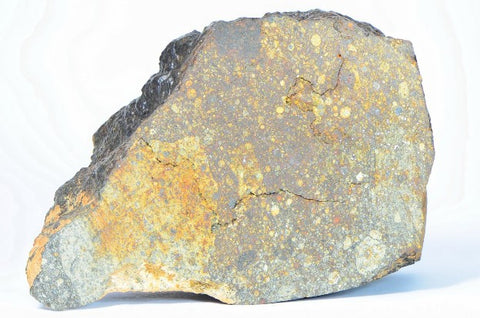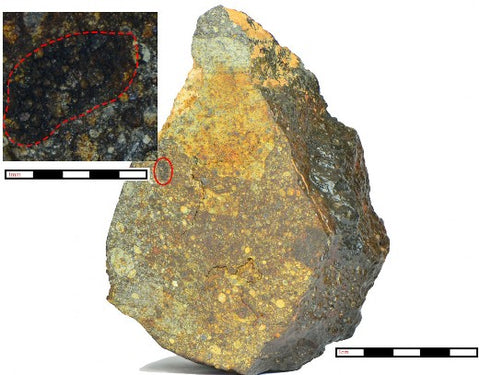The Chimeric Clast | The Discovery of a New Kind of Meteorite
Posted by Appifycart Support on

*First Published in the May, 2016 edition of Meteorite Times Magazine
In a rare event in the field of meteoritics, researchers at UCLA quietly announced the discovery of a new kind of ordinary chondrite in an abstract submitted to the 47th Lunar and Planetary Science Conference. This two page abstract is a precursor to a much more in depth paper soon to be published with a working title of, ‘A new kind of chondrite: Matrix rich clast in the NWA 10214 LL3 chondrite breccia’, authored by Alan Rubin et al, which explains that in addition to sporting characteristics of several classes of meteorite, this matrix rich clast also shows chemistries unlike anything studied to date.
Though generally referred to as Clast 6 in the paper, it’s been dubbed the “Chimeric Clast” by lead author Alan Rubin. It would be difficult to calculate the total known weight or (TKW) of this new meteorite, as it isn’t even a whole stone. Rather, it’s a small clast embedded within another meteorite. The clast was found in the LL3 chondrite known simply as Northwest Africa 10214. The host meteorite is officially classified as an LL3 with the Meteoritical Society’s Nomenclature Committee, however the authors drill down on this high level description to a much finer detailed classification. The paper clarifies NWA 10214 as being a type3 LL 3.7 fragmental genomict breccia. It reports the meteorite contains ~8% clasts. These fragments represent a variety of LL5, LL6 and other shock altered LL material as well as the Chimeric Clast.
The Chimeric Clast is a dark xenolithic unequilibrated matrix rich chondritic inclusion that the authors suspect was embedded into the host stone’s parent asteroid as a projectile traveling at a low relative velocity. The paper also explain that the ‘chimeric’ moniker was chosen because the clast displays chemical and textural characteristics of three different types of chondrites, just as the mythical chimera beast of antiquity was made of the similarly incongruent lion, goat, and snake.

One of the paper’s coauthors, Sean Tutorow, was the first to notice the clast rich region of the host meteorite while he was cutting and examining the stone prior to classification. The new chondrite is only a small part of a much larger 1.8 kilogram meteorite riddled with a variety of dark clasts. After conferring with Dr. Rubin by phone about the extraordinary lithology, Sean selected a particularly clastfull slice and used a black sharpie to indicate the points of greatest interest. The marked-up slice was carefully packaged and sent to Dr. Rubin at UCLA for analysis. After extensive scrutiny and painstaking synthesis of the data, it was clear this was no ordinary Ordinary Chondrite. They had found something new.
How exactly is the Chimeric Clast related to the other types of chondrites? In broad terms, the paper describes the clast as displaying the distorted heads of ‘Carbonaceous’, ‘Ordinary’, and ‘Enstatite’ chondrites. Breaking it down much the way the authors of the paper do, we can tackle the specific ways Clast 6 both shows affinities for, and divergences from, these three classes of chondritic meteorites.
The Carbonaceous Chondrite Connection: The paper describes a textural similarity of the percentage of matrix to chondrules in Clast 6, [~60% matrix to ~20% chondrules], that is indicative of a CM carbonaceous chondrite. A lone cosmologically ancient refractory inclusion known as a CAI further reinforces what seems to be an obvious carbonaceous lithology.
However, on closer inspection the chondrules themselves show no similarity to CM or any other type of carbonaceous chondrite.
The Enstatite Chondrite Connection: Chondrule types, and how often they occur within a given area of a sample can offer useful diagnostic information about a chondrite. According to the paper, the ratio of pyroxenerich chondrules to olivinerich chondrules in the Chimeric Clast is most like the metalrich type3 enstatite chondrite (EH3). However, the lack of nonporphyritic chondrule types; RP, C and GP within the clast clearly distinguish it from an EH3.
The Ordinary Chondrite Connection: When it comes to meteorite classification, oxygen isotopic analysis can often be the final word. The authors of the paper report that oxygen isotopic compositions of the chondrules within the clast to be similar to unequilibrated type3 H ordinary chondrites. This establishes a strong connection to the ordinary chondrite class, despite a distinct lack of overall tectural affinity. So, even while the abundance of chondrules to matrix and the ratios of chondrule types points to two other type of chondrite, researchers have high confidence the actual chondrules within the chimeric clast are essentially akin to those in type3 H ordinary chondrites.
The complexity, and to some degree high art, of discerning where within the cracks of the existing meteoritic taxonomy a completely new type of meteorite belongs, is utterly staggering. In the end, the paper concludes the chimeric clast is best classified as an entirely new kind of unequilibrated ordinary chondrite. This, despite a CAI and gross textures that simultaneously scream carbonaceous, and softly whisper enstatite. Once again, oxygen work takes the day.
In an eloquent narrative in the Discussion section of the paper, the authors propose a model for how Clast 6’s parent body may have formed and how a piece of that parent body may have ended up as a clast inside of NWA 10214. It begins by suggesting that due to the low shock in both the clast and the host LL3 meteorite, it was likely introduced into the host meteorite’s parent LL asteroid as a projectile at lowrelative velocity.
The authors characterize the formation of the chimeric clast parent body as a type3 ordinary chondrite that acquired an unusually high volume of matrix during formation. While being very
type3 H like, it formed in a somewhat less oxygen rich (or reduced) environment than other known type3 H chondrites. They explain the clast parent body likely formed in a nebular region where aerodynamic radialdrift processes had concentrated a large amount of CAI and matrix material. The paper also indicates there may have been a small degree of aqueous alteration on the clast parent body after formation.
With an idea of how the clast formed, how did it get here? The chain of events that led NWA 10214 and the Chimeric Clast to this planet may go something like this. The Chimeric Clast parent asteroid is struck by another large asteroid, which sends fragments pummeling into and embedding within the parent asteroid of host meteorite NWA 10214. A bit later, yet another asteroid hits the Chimeric Clast impregnated parent asteroid of host meteorite NWA 10214. This creates the host LL3.7 meteorite with its breccia of dark clasts. The same impact that creates NWA 10214, also ejects it into what ultimately becomes an Earth crossing trajectory. It then misses the Moon and somehow makes it into the ablative hell of passing through our atmosphere. Rapidly shedding cosmic velocity without completely vaporizing, it slows and drops from the sky missing the many oceans and lakes covering 75% of the planet. It falls in a place that a human paying attention to such things can retrieve it. Nothing short of impossible.
How prolific the chimeric material is within the host meteorite remains to be determined, but there is hope more clasts will be identified as further study of the main mass and several large slices continues. While many collectors and researchers alike seem to focus more and more on the new bounty of planetary meteorites flooding the market, I for one am quite happy the ordinary chondrite is back in the news.
Share this post
0 comment
